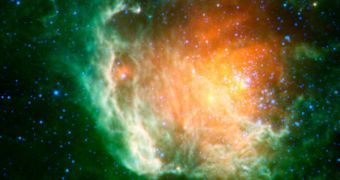Researchers operating one of the American space agency's newest space-based telescopes announce the discovery of a new cluster of young stars deep in space. The structure, which is currently producing young, blue stars at a frantic rate, looks beautiful, and astronomers have likened it to a rose. Flower-like wisps of interstellar dust agglomerate inside the newly-found structure, and they are the main sources of all the new fireballs. Most of the stars inside this formation have been found to be no more than a few million years old, which is nothing but a glimpse in geological terms, Space reports.
The Wide-field Infrared Survey Explorer (WISE) telescope was launched on December 14, 2009, and its main job is to produce a full survey of the known Universe in infrared wavelengths. Its photon detectors are incredibly sensitive, and researchers managing it hope to catch glimpses of hidden objects that are hiding from other observatories, such as ultra-cold asteroids and other space rocks, brown dwarfs and very distant galaxies. All these targets are so cold, that they are invisible in the visible light-range of the electromagnetic spectrum, the astronomers say.
The new cluster, called Berkeley 59, was found some 3,300 light-years away from our planet, in the direction of the Cepheus Constellation. According to experts at the NASA Jet Propulsion Laboratory (JPL), in Pasadena, California, the new image of the structure also reveals what has been called a “champagne flow.” These are remnants inside the cluster that originated from the supernova NGC 7822. This structure was once a star inside the cluster, but it exploded violently, stirring up the gas and dust in its vicinity. As seen in the image, the entire cluster – which is in fact a stellar nursery – is flooded in green and red hues, in addition to the myriad of blue dots that represent young stars.
According to scientists, these hues are produced by the powerful heating effects that the stars have on the surrounding gas. This is especially true for the reddish color. The green regions show the exact boundaries of the massive gas cloud that houses the nursery. The emerald hues come from light striking compounds known as polycyclic aromatic hydrocarbons, which can also be found on Earth. They are mainly produced through combustion effects from barbecue pits and exhaust pipes.

 14 DAY TRIAL //
14 DAY TRIAL //